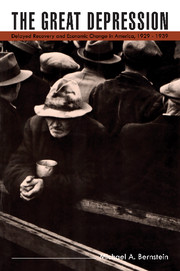Book contents
- Frontmatter
- Contents
- List of tables
- List of figures
- Editors' preface
- Preface
- Introduction: The puzzle of the 1930s
- 1 Long-term economic growth and the problem of recovery in the United States, 1929–39
- 2 The transformation of American industry in the interwar period
- 3 A reassessment of investment failure in the interwar economy
- 4 Technical change during the interwar years
- 5 The effective demand problem of the interwar period. I: Cyclical and structural unemployment
- 6 The effective demand problem of the interwar period. II: Cyclical and secular changes in final demand
- 7 New Deal economic policy and the problem of recovery
- 8 Contemporary economic problems in historical perspective
- Bibliography
- Index
Introduction: The puzzle of the 1930s
Published online by Cambridge University Press: 06 July 2010
- Frontmatter
- Contents
- List of tables
- List of figures
- Editors' preface
- Preface
- Introduction: The puzzle of the 1930s
- 1 Long-term economic growth and the problem of recovery in the United States, 1929–39
- 2 The transformation of American industry in the interwar period
- 3 A reassessment of investment failure in the interwar economy
- 4 Technical change during the interwar years
- 5 The effective demand problem of the interwar period. I: Cyclical and structural unemployment
- 6 The effective demand problem of the interwar period. II: Cyclical and secular changes in final demand
- 7 New Deal economic policy and the problem of recovery
- 8 Contemporary economic problems in historical perspective
- Bibliography
- Index
Summary
The essential point to grasp is that in dealing with capitalism we are dealing with an evolutionary process. It may seem strange that anyone can fail to see so obvious a fact. … Yet that fragmentary analysis which yields the bulk of our propositions about the functioning of modern capitalism persistently neglects it.
– Joseph A. SchumpeterIn American economic history, there is no greater puzzle than the persistent failure of investment activity during the depression of the 1930s to generate a full recovery. What investment did take place during the decade was limited by the low demand for output. But cyclical recoveries require an increase in investment expenditures large enough to make additions to productive capacity, create jobs, and expand output. In the absence of technical change, the rate of net investment will fall to zero so soon as the rate of increase in consumption levels off. For consumption expenditures to rise consistently, there must be net investment or continual injections of government spending. This is the essential paradox of the thirties. Consumption was constrained both by deficient investment and by political limits to countercyclical fiscal policy. The solution, a recovery in net investment, was not forthcoming, because of inadequate demand.
Most research concerning the Great Depression in particular, and business cycles in general, examines the behavior of economic aggregates and thereby limits its effectiveness in two ways: (1) by often ignoring structural changes within the aggregates and (2) by implicitly assuming that cycles are inherently the same irrespective of the point in the history of a given economy at which they occur.
- Type
- Chapter
- Information
- The Great DepressionDelayed Recovery and Economic Change in America, 1929–1939, pp. 1 - 20Publisher: Cambridge University PressPrint publication year: 1987

